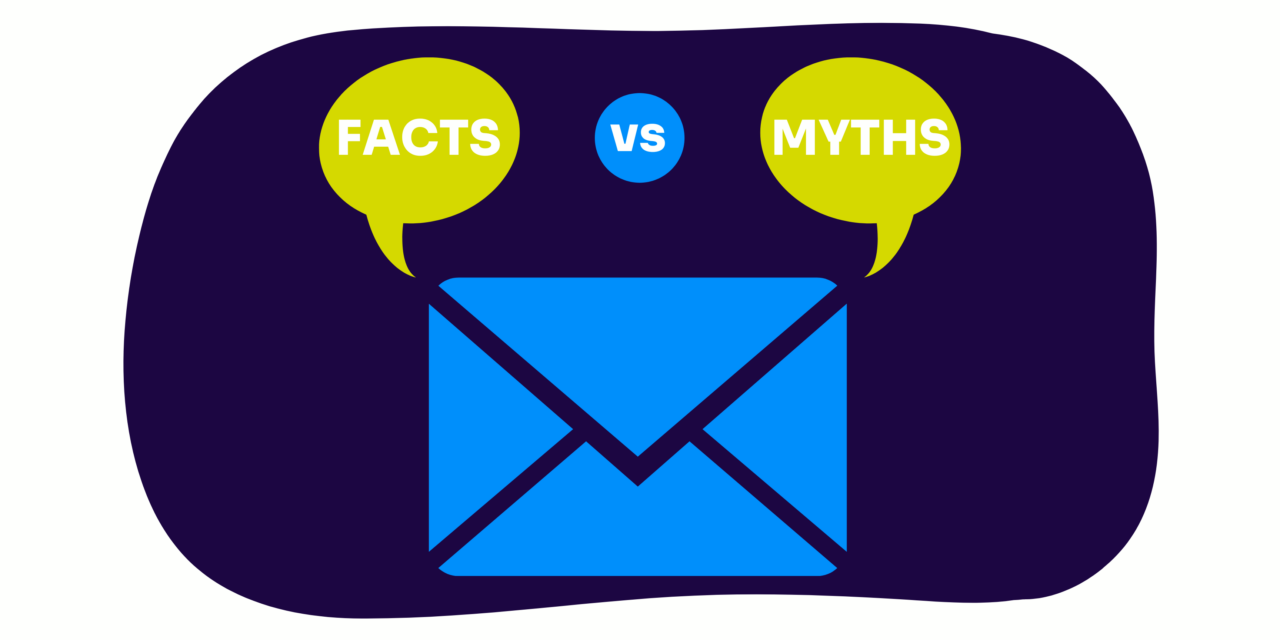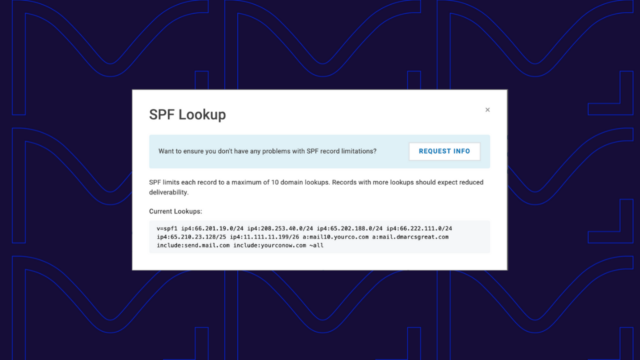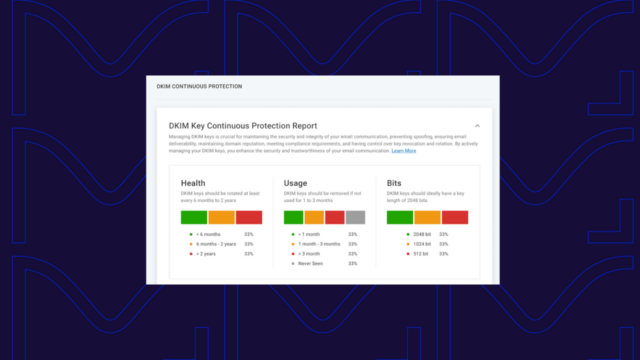The new Google and Yahoo sender guidelines changes are coming soon, and the email landscape is buzzing with rumors and activity. It’s a breath of fresh air for marketers and senders to focus on improved sending habits, but plenty of myths and misconceptions are floating around, muddling the waters.
We’re here to help set the record straight. While we can’t cover every fallacy out there, we will do our best to reveal the truth behind the upcoming changes.
- 16 misconceptions and myths about the coming Google and Yahoo changes
- 1. Myth: Google and Yahoo's new guidelines only apply to bulk senders.
- 2. Myth: You need to comply with all these changes before February 2024.
- 3. Myth: You only need to reach a DMARC policy of p=none to protect yourself.
- 4. Myth: Implementing the changes is too complex for small businesses with limited resources.
- 5. Myth: The changes will hurt legitimate email marketing efforts.
- 6. Myth: These changes only require a one-time upfront effort.
- 7. Myth: My company already has a good sender reputation, so we don't need to worry.
- 8. Myth: We only send transactional emails, so these changes don't apply to us.
- 9. Myth: My email list is permission-based, so I won't get flagged.
- 10. Myth: Implementing these changes will require major technical expertise.
- 11. Myth: We can just wait and see how things play out before making changes.
- 12. Myth: We can get around the changes by using separate sub-domains for marketing emails.
- 13. Myth: We're not a bulk sender anymore, so we don't need to worry about this right now.
- 14. Myth: We just need to maintain a spam rate of 0.3% or lower to comply.
- 15. Myth: We already have an unsubscribe link in our footer, so we're good to go on these new guidelines.
- 16. Myth: It's okay to quickly scale up your sending volume if you've followed all the other guidelines and best practices.
- Authenticate your emails with Valimail
16 misconceptions and myths about the coming Google and Yahoo changes
1. Myth: Google and Yahoo’s new guidelines only apply to bulk senders.
Truth: The email sender guidelines apply to all senders, including individual businesses and even personal email accounts. While the focus might be on high-volume senders initially, everyone will eventually need to comply to maintain good deliverability.
2. Myth: You need to comply with all these changes before February 2024.
Truth: Google recently refined the timeline for enforcing its updated email sender guidelines, giving businesses more breathing room to prepare. Starting February 1, 2024, you’ll need to comply with the general email-sending practices outlined in Google’s guidelines.
However, messages won’t start getting rejected until April 2024. Learn more about Google’s updated timeline.
3. Myth: You only need to reach a DMARC policy of p=none to protect yourself.
Truth: The new Google changes only require you to reach a DMARC policy of p=none, but this is simply a reporting status—it’s not actually protecting your brand from phishing and impersonation attempts yet.
While it’s a start, you’ll eventually want to reach a policy of p=quarantine or p=reject to achieve true email security benefits.

4. Myth: Implementing the changes is too complex for small businesses with limited resources.
Truth: Going it alone isn’t easy, but that’s why we’re here to help. Regardless of your size or sending volume, Valimail’s solutions and expertise can help you reach DMARC enforcement and on your path toward compliance.
5. Myth: The changes will hurt legitimate email marketing efforts.
Truth: While stricter authentication protocols might initially lead to temporary fluctuations in deliverability, the long-term goal is to create a more secure and trustworthy email ecosystem for everyone.
This, in turn, can benefit legitimate senders by reducing competition from spammers and increasing email engagement.
6. Myth: These changes only require a one-time upfront effort.
Truth: Maintaining a good sender reputation is an ongoing process. Businesses need to continuously monitor their email metrics, adapt their sending practices, and implement new authentication protocols as they arise.
While these updated guidelines will likely require sending changes for many companies, it’ll take continuous effort to maintain quality engagement and low spam rates.
7. Myth: My company already has a good sender reputation, so we don’t need to worry.
Truth: A good reputation needs maintenance. New protocols, evolving algorithms, and potential slip-ups can tarnish even the best. Proactive adaptation ensures you stay ahead of the curve and deliver the game.
While a positive reputation is a great starting place, you’ll need to follow these guidelines to ensure your messages still reach Gmail and Yahoo inboxes.
8. Myth: We only send transactional emails, so these changes don’t apply to us.
Truth: Even transactional emails need sender authentication for timely delivery and brand protection. Domain and IP reputation built through proper authentication protocols like SPF, DKIM, and DMARC ensure even crucial messages reach inboxes, avoid spam filters, and build trust with recipients.
Remember, the changes aim for a secure and reliable email ecosystem for all types of senders, including transactional ones.
9. Myth: My email list is permission-based, so I won’t get flagged.
Truth: Permission alone doesn’t guarantee inbox placement. Regular list cleaning, engagement monitoring, and compliance with authentication protocols are crucial to maintain delivery. Inactive users, accidental unsubscribes, and low engagement can still trigger spam filters, even with consent.
Proactive list hygiene and authentication show your commitment to best practices and user experience.
10. Myth: Implementing these changes will require major technical expertise.
Truth: Many tools and resources simplify compliance, even for non-technical users. Many email service providers (ESP) can provide actionable advice for lowering your spam rate and ensuring list hygiene, while tools like Valimail can ensure you properly implement authentication protocols like SPF, DKIM, DMARC, and BIMI.
11. Myth: We can just wait and see how things play out before making changes.
Truth: Proactive adaptation secures your future. Early adopters gain a competitive edge in a cleaner inbox environment and avoid potential deliverability hiccups later. Waiting can mean missed opportunities. Implementing now helps build long-term trust with users, improves deliverability, and boosts marketing ROI.
Waiting is like leaving your holiday shopping until Christmas Eve—stressful, crowded, and potentially disappointing. Get ahead of the curve to enjoy inbox peace of mind.
12. Myth: We can get around the changes by using separate sub-domains for marketing emails.
Truth: Domain reputation travels across your brand network. Google and Yahoo can associate sender reputation across domains related to the same organization. Isolating marketing emails to a separate sub-domain might seem like a temporary fix, but it won’t shield your overall reputation from potential damage.
Implementing consistent authentication and best practices across all sending domains, regardless of purpose, is crucial for long-term deliverability and brand protection.
13. Myth: We’re not a bulk sender anymore, so we don’t need to worry about this right now.
Truth: Once a bulker sender, always a bulk sender. Even if you sent 5,000 emails only once years ago, you’re still classified as a bulk sender by Google—and that means you need to get your ducks in a row, regardless of your sending volume today and tomorrow.
14. Myth: We just need to maintain a spam rate of 0.3% or lower to comply.
Truth: 0.3% is the red line, not the goal. Aiming for a sub-0.1% spam rate shows proactive commitment to user experience and protects you from potential deliverability issues even with minor fluctuations.
While staying below 0.3% avoids immediate penalties, a sustained rate above 0.1% can still attract scrutiny and impact deliverability. Prioritize best practices and consistent engagement to remain comfortably below the threshold and enjoy improved inbox placement.
15. Myth: We already have an unsubscribe link in our footer, so we’re good to go on these new guidelines.
Truth: A simple footer link isn’t enough anymore. The new guidelines require a “one-click unsubscribe” button prominently displayed in the email header. This means one click, no hoops, no jumping through pages—just instant opt-out for a seamless user experience.
While a footer link is helpful, its placement and design matter. Make it prominent, visible, and user-friendly. Remember, easy unsubscribe demonstrates respect for recipients and boosts engagement.
Simplifying unsubscription isn’t just good for user experience—it’s crucial for your sender reputation. Frustrated users who can’t unsubscribe are more likely to mark emails as spam, impacting your deliverability. Make it easy, and everyone wins.
16. Myth: It’s okay to quickly scale up your sending volume if you’ve followed all the other guidelines and best practices.
Truth: Sudden spikes in volume can trigger spam filters, even for reputable senders. Think of it like warming up a car engine—start slow and gradually increase to avoid sputters and stalls in your email delivery.
Building your sender reputation takes time and consistency. Even with best practices in place, rapid volume increases can raise flags and hinder the trust you’ve established. Slow and steady scaling allows reputation to adapt and maintain good deliverability.
Start small, track your metrics, and adjust gradually. Monitor open rates, unsubscribe rates, and spam complaints to ensure your growing volume doesn’t negatively impact user experience or reputation. Slow and measured growth builds a sustainable foundation for future success.
Authenticate your emails with Valimail
The upcoming Google and Yahoo sender requirement changes might seem daunting, but they’re a golden opportunity for legitimate senders to cement their positive foundation with inbox providers. Fortunately, you don’t have to do it all alone—we’re here to help.
At Valimail, we’re dedicated to empowering businesses of all sizes with the tools and expertise they need to achieve and maintain email compliance. Our comprehensive solutions make implementing SPF, DKIM, and DMARC a breeze, and our ongoing support protects your sender’s reputation for the long term.
Valimail Align is your fast track to the email sender requirement compliance. This tool gives you confidence in your compliance status across your sending services. We use automation to seamlessly align your SPF and DKIM, granting you uninterrupted email delivery without reaching full DMARC enforcement.
Check out this tool and get to compliance in a matter of days, rather than weeks.



